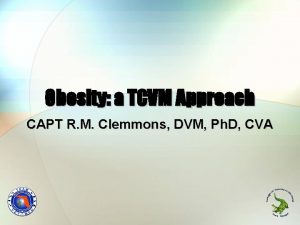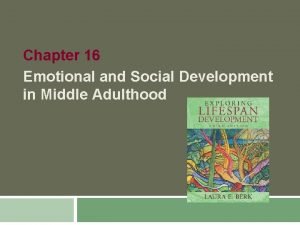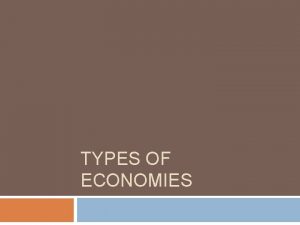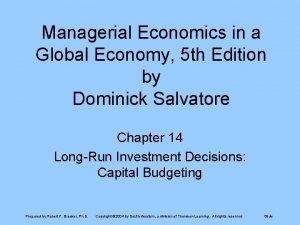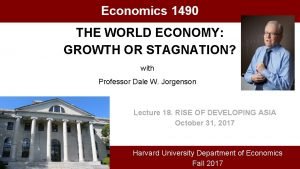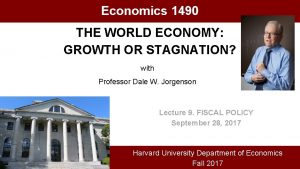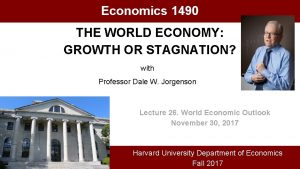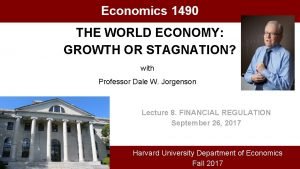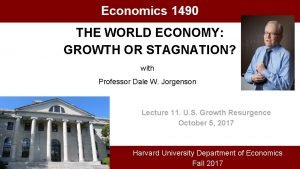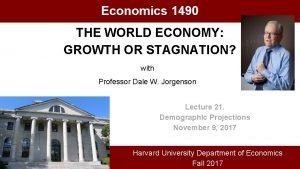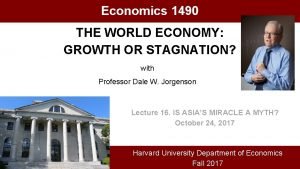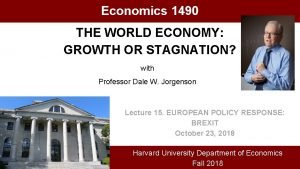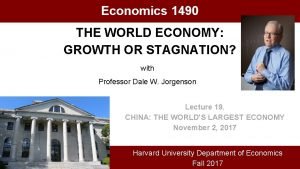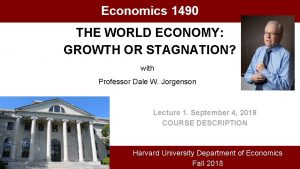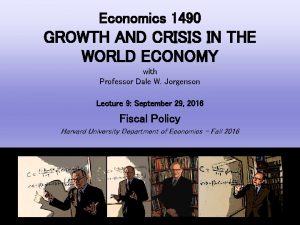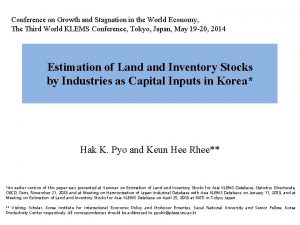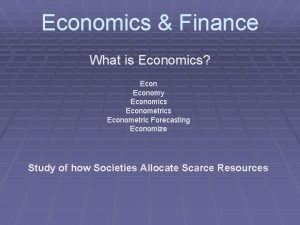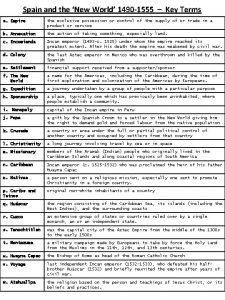Economics 1490 THE WORLD ECONOMY GROWTH OR STAGNATION


























- Slides: 26

Economics 1490 THE WORLD ECONOMY: GROWTH OR STAGNATION? with Professor Dale W. Jorgenson Lecture 6. U. S. FINANCIAL CRISIS September 19, 2017 Harvard University Department of Economics Fall 2017

THE WORLD ECONOMY: GROWTH OR STAGNATION? A. Comparing Economies B. U. S. Crisis and Recovery C. European Slowdown D. Asian Economic Miracles E. Sustainability of Economic Growth F. World Economic Outlook

B. U. S. CRISIS AND RECOVERY 6. U. S. Financial Crisis 7. Monetary Policy 8. Financial Regulation 9. Fiscal Policy 10. Secular Stagnation

SUPPLEMENTARY READING Gretchen Morgenson and Joshua Rosner (2011), Reckless Endangerment: How Outsized Ambition, Greed, and Corruption Led to Economic Armageddon, New York, Times Books. A good journalistic account of the crisis. James B. Stewart (2009), “Eight Days: The Battle to Saving the U. S. Financial System, ” The New Yorker, September. This represents the “banking view” discussed by Mian and Sufi. Ben S. Bernanke (2015), The Courage to Act: A Memoire of a Crisis and Its Aftermath, New York, Norton. A very detailed account by a leading participant.

TIME LINE OF THE FINANCIAL CRISIS • March 14: Federal Reserve Provides Financial Backing to JPMorgan Chase's Purchase of Bear Stearns. • September 7: Federal Government Bails Out Fannie Mae and Freddie Mac. • September 12: Treasury Secretary Hank Paulson States That No Government Money Can Be Used in Any Rescue. • September 13: Barclay's Purchase of Lehman Vetoed by British Regulators. • September 15: Lehman Brothers Bankruptcy. • September 16: Fed Announces $85 Billion Bailout of AIG. • October 3: Congress Passes Troubled Asset Relief Program. • October 14: TARP Equity Program Announced by the Treasury.

HOUSE OF DEBT • • Debt and Destruction Cutting Back Levered Losses: Theory Explaining Unemployment

DEBT AND DESTRUCTION • The Harshness of Debt • Debt and Wealth Inequality in the Great Recession • How the Poor Got Poorer • The Geography of Net Worth Destruction • Foreclosures and Fire Sales • Debt: The Anti-Insurance

LEVERAGE RATIO Leverage Ratio for Home Owners, 2007, by Net Worth Quintile

NET WORTH Chart 2. Net worth, Lowest, Median, and Highest Net worth quintiles

FORECLOSURES

CUTTING BACK • The Consumption-Driven Recession • Where Spending Declined • What’s Debt Got to Do with It? • More Than a Wealth Effect • A Summary of the Evidence

WHAT DROVE RECESSION?

SPENDING AND NET WORTH

SPENDING ON AUTOS

LEVERED LOSSES: THEORY • The Fundamentals View and Robinson Crusoe • The Levered Losses Framework • How Does the Economy Try to React? • The Frictions • We Are in This Together • Reallocation?

EXPLAINING UNEMPLOYMENT • Quantifying Jobs Lost • Frictions, Frictions • Why Unemployment? • Levered Losses: A Summary

EMPLOYMENT DECLINE

HOUSE OF DEBT: SUMMARY • The relationship between elevated household debt, asset-price collapses, and severe contractions is ironclad. • Debt amplifies the decline in asset prices due to foreclosure and by concentrating losses on the indebted, who are almost always the households with the lowest net worth in the economy. • This is especially dangerous because the spending of indebted households is extremely sensitive to shocks in their net worth …. • The demand shock overwhelms the economy and the result is economic catastrophe. • But so far we have avoided a central question: How does an economy get into this levered-losses trap in the first place? • Mian and Sufi, pages 70 -71.

PETER J. WALLISON I believe that the sine qua non of the financial crisis was U. S. government housing policy, which led to the creation of 27 million subprime and other risky loans—half of all mortgages in the United States—which were ready to default as soon as the massive 1997– 2007 housing bubble began to deflate. If the U. S. government had not chosen this policy path—fostering the growth of a bubble of unprecedented size and an equally unprecedented number of weak and high-risk residential mortgages—the great financial crisis of 2008 would never have occurred.

NON-TRADITIONAL MORTGAGES • A subprime mortgage is a loan to a borrower who has blemished credit, usually signified by a Fair Isaac Corporation (FICO) credit score lower than 660. • An Alt-A mortgage is one that is deficient by its terms. It may have an adjustable rate, lack documentation about the borrower, require payment of interest only, or be made to an investor in rental housing, not a prospective homeowner. Another key deficiency in many Alt-A mortgages is a high loan-tovalue ratio—that is, a low down payment. • Mortgage-backed securities (MBS). Securities backed by a portfolio of mortgages, mostly created by Government Sponsored Enterprises (GSE'S): Federal National Mortgage Association (Fannie Mae) and Federal Home Loan Mortgage Corporation (Freddie Mac). • Private mortgage-backed securities (PMBS): Securities backed by mortgages and created by private corporations.

MORTGAGE HOLDINGS

CREDIT RISK

U. S. GOVERNMENT HOUSING POLICY Initiated by Congress in 1992 and pressed by the U. S. Department of Housing and Urban Development (HUD) in both the Clinton and George W. Bush administrations, U. S. government housing policy sought to increase home ownership through an intensive effort to reduce mortgage underwriting standards. HUD used (i) the affordable housing requirements [AH] imposed by Congress in 1992 on the government-sponsored enterprises (GSEs) Fannie Mae and Freddie Mac, (ii) its control over the policies of the Federal Housing Administration (FHA), and (iii) a “Best Practices Initiative” for subprime lenders and mortgage banks to encourage greater subprime and other high-risk lending.

GSE ACT OF 1992 • Title XIII of the Housing and Community Development Act of 1992 (the GSE Act) gave low- and moderate-income borrowers better access to mortgage credit through Fannie Mae and Freddie Mac through affordable housing (AH) goals • HUD consistently enhanced and enlarged the AH goals. Congress initially specified that 30 percent of the GSEs’ mortgage purchases meet the AH goals. This was increased to 42 percent in 1995 and 50 percent in 2000. By 2008, the goal was 56 percent and a special affordable subgoal had been added requiring that 27 percent of the loans acquired by the GSEs be made to borrowers who were at or below 80 percent of area median income (AMI)… • September 7, 2008: Fannie Mae and Freddie Mac were placed into conservatorship of the Federal Housing Finance Agency.

COMMUNITY REINVESTMENT ACT • 1995: Community Reinvestment Act (CRA) regulations tightened. The CRA and its associated regulations required insured banks and S&Ls to demonstrate that they were actually making loans in low-income communities and to low-income borrowers. A qualifying CRA loan was one made to a borrower at or below 80% of the AMI and thus was similar to the loans that Fannie and Freddie were required to buy under HUD’s AH goals. • In 1994, HUD set up a Best Practices Initiative to which 117 members of the Mortgage Bankers Association eventually adhered. This program was intended to encourage a reduction in underwriting standards so as to increase access by low-income borrowers to mortgage credit.

MIAN AND SUFI MEET WALLISON • MAGNIFICATION: The Impact of the Decline in Housing Prices Is Magnified by the Distribution of Leverage by Net Worth and Differences in Cutting Back Expenditures by the Leverage of Households. • U. S. GOVERNMENT HOUSING POLICY: Government Policy is a Possible Answer to Mian and Sufi’s Question, How Does an Economy Get into the Levered Losses Trap in the First Place? • VULNERABILITIES: The Decline in Housing Prices Triggers a Financial Crisis through the Vulnerability of the Banks and an Economic Crisis through the Rise in Unemployment. • COMPOUNDING: The Economy Is Unable to Adjust and the Downturn Becomes the Great Recession of 2007 -2009.
 Christopher columbus journey map
Christopher columbus journey map Landmarks in humanities
Landmarks in humanities The economy: economics for a changing world
The economy: economics for a changing world Answert the public
Answert the public Generativity vs stagnation
Generativity vs stagnation Blood stagnation treatment
Blood stagnation treatment Stagnation pressure formula
Stagnation pressure formula Intimacy vs isolation
Intimacy vs isolation Industry vs inferiority example
Industry vs inferiority example Generativity stage
Generativity stage Generativity vs stagnation
Generativity vs stagnation Maladaptation of industry vs inferiority
Maladaptation of industry vs inferiority Courbe de croissance fille 0-2 ans
Courbe de croissance fille 0-2 ans Athens and sparta were both
Athens and sparta were both Traditional economy definition economics
Traditional economy definition economics Traditional economy definition economics
Traditional economy definition economics Three types of economics
Three types of economics Economics mixed economy
Economics mixed economy Traditional economy definition economics
Traditional economy definition economics Managerial economics in a global economy
Managerial economics in a global economy Maastricht university economics and business economics
Maastricht university economics and business economics Econ213
Econ213 Growth analysis definition
Growth analysis definition Ground tissue
Ground tissue Step growth polymerization vs chain growth
Step growth polymerization vs chain growth Primary growth and secondary growth in plants
Primary growth and secondary growth in plants Chapter 35 plant structure growth and development
Chapter 35 plant structure growth and development





